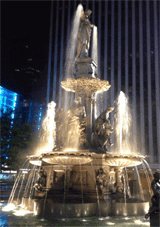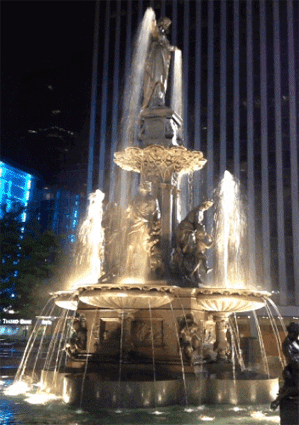Tyler Davidson fountain

Public Art: Tyler Davidson fountain
Also known as: The Genius of Water
Sculptors: © August von Kreling (23rd May 1819 – 23rd April 1876), Ferdinand von Miller (18th October 1813 — 11th February 1887), Ferdinand Freiherr von Miller (1842–1929) son and Fritz von Miller (son).
Description: This fountain is one of Cincinnati’s best known and loved icons. The 43ft (13m) Genius of Water fountain, which was erected in honor of Cincinnati businessman Tyler Davidson, is cast in bronze. Atop the fountain stands a 9ft (2,7m) bronze woman “The Genius” with her arms outstretched. The water streams down her arms before cascading down into the central basin. This was designed by August von Kreling. The four outer sculptures, which are also double as drinking fountains, feature boys riding animals and they were designed by Ferdinand von Miller, the youngest son . The seated figures at the base of the fountain were designed by Fritz von Miller, the other son. The massive granite stones are from Bavaria.
Date Unveiled: The fountain was dedicated on October 6, 1871. Over 20,000 turned out for the event. The sculptor, Ferdinand von Miller (the younger), was also in attendance.
Cast: The fountain was cast at the Royal Foundry in Munich, which was founded by King Ludwig I of Bavaria in 1824, and was later owned by Ferdinand von Miller in 1844. It took three years to cast the fountain.
Location: Not only has the fountain faced every which way except north, but it has also been moved several times. The Genius of Water can be found at Fountain Square (also a gift to the city from Henry Probasco) in Cincinnati, Ohio.
Acknowledgments: A special thank you to Bearman Cartoons for kindly providing the photograph.

History of the Genius of Water fountain: In 1860 hardware business partners and brothers-in-law Tyler Davidson and Henry Probasco discussed the idea of dedicating a fountain to the people of Cincinnati. Having made a fortune from the business they wanted to give something back to the community.
Unfortunately, Tyler Davidson died in 1865 before their dream was realised. When Henry sold the hardware business he decided to continue pursuing the fountain idea. Henry headed to Europe in search of the perfect fountain. He had specific ideas about what he wanted. Firstly it had to be practical so people could drink from it and secondly, he wanted no conventional design e.g mythological symbols and especially no Neptune.
Eventually, he was introduced to Ferdinand von Miller of the Royal Foundry of Bavaria. Miller showed Henry a rejected fountain design by himself and August von Kreling, which depicted figures of everyday people enjoying water in different ways.
Henry loved it and placed an order. It took three years to cast and complete. When finished the fountain was packed into crates and sent to America on the steamship “Westphalia.” Along with the precious cargo was Ferdinand’s youngest son, Ferdinand Jr, who was sent to supervise the assembling.
Not Everyone Loved The Fountain: When Ferdinand von Miller and artist August von Kreling collaborated on designing a grand fountain they were very excited about their radical concept. Ferdinand had included his “Genius” statue with outstretch arms, while August had removed all mythological elements and replaced them with human figures.
Keen to begin, the two used the upcoming German Industrial Exposition as an excuse to start planning their fountain. Ferdinand decided to give King Ludwig a sneak peek of the design, which, in hindsight was a fatal mistake. He hated it. In fact, he called it an “abomination in the arts”. After the dust had settled Ferdinand decided to approach the king again, in hope he had warmed to the idea. No such luck, he hated it even more. So Ferdinand and August quietly shelved the project. That was until Henry Probasco appeared.
Stone Controversy: Many locals in Cincinnati, especially the men working on the project, were not happy that the granite base stones for the fountain were imported from Germany when America could have easily have supplied the same stones of equal quality. They were even less impressed with the fact a Bavarian was supervising the installation.
Rope Controversy: When Ferdinand arrived in Cincinnati the first thing he noticed were the ropes provided by the locals to hoist the heavy crates were way too thin to handle the weight. When he mentioned this, he was met with stubborn refusal to change the ropes. In desperation Ferdinand suggested they hang one of the heaviest crates by the ropes overnight just to be on the safe side. Needless to say, the next day the ropes had been mysteriously changed to thicker ones and not another word was said about the subject.
Water Controversy: When it was time for Ferdinand to test the water pressure for the fountain, he opened the valve on the main pipe and no water came out of the upper statue’s hands. A disaster in the making. Fortunately, there was another water source (city reservoir) that could provide enough force for the water to rise the 40ft needed to reach the hands. Problem? The pipes only ran a small distance down Vine Street. The city council ordered an immediate extension of the pipes so that they could reach the fountain. Men worked day and night digging up the street to lay the new pipes. After a few plumbing alterations, the Genius flowed into life.
Trivia: It is estimated that 500 gallons of water flow through the fountain every minute.
The fountain featured in the opening credits of the television series WKRP in Cincinnati.
The fountain was renovated for the first time in 1970 for a celebration of its centennial.
The inspiration for the woman at the top of the fountain came from Ferdinand von Miller. When he was a young man Ferdinand had bought a medallion from a shop near a church in France which had an image of the Virgin Mary on it. He was intrigued by the way the designer had depicted Mary, with arms outstretched and shafts of light emanating from her palms. He later used a similar concept for his fountain but replaced the shafts of light with water.
The bronze used for the fountain came from old cannon purchased from the Danish government.
The Tyler Davidson Fountain is made of approximately 24 tons of bronze and 85 tons of granite.
In 1867 a bronze model of the fountain was given to Henry Probasco by Ferdinand von Miller and for many years it stood outside Henry’s home. It now resides in the Cincinnati Museum of Art.
When the fountain was transported to America, several pieces were too large fit in the hold of the steamship so they were chained to the deck.
When the ship arrived in New York on September 6, 1871, the ship, the fountain and the passengers were quarantined for two days, thanks to a breakout of cholera during the voyage which had resulted in the death of five passengers.
References: www.historicfountains.com